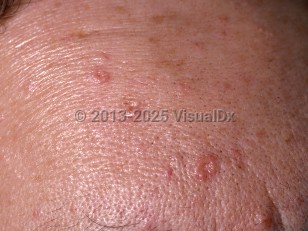Sebaceous hyperplasia
Alerts and Notices
Important News & Links
Synopsis

Classically, sebaceous hyperplasia affects middle-aged to older adults, where it is seen in more than 25% of individuals. It also has been noted to rarely occur in the peripubertal and young adult age group, often in a familial pattern.
Sebaceous hyperplasia may also be present on the nipples, where it is referred to as Montgomery's tubercles, and on anogenital regions of the foreskin, penile shaft, scrotum, and vulva, where the differential diagnosis would include molluscum contagiosum and human papillomavirus (HPV).
Juxtaclavicular beaded lines (JCBLs) is a unique presentation of sebaceous hyperplasia presenting as small (0.5-1.5 mm), slightly yellow papules in a linear pattern occurring in lines of cleavage localized to the low neck and juxtaclavicular areas. Unlike classic sebaceous hyperplasia, this condition presents earlier in life, starting during or just after puberty.
Sebaceous hyperplasia is seen in up to 30% of renal transplant patients receiving cyclosporin as immunosuppression and is also reported to affect heart and hematopoietic stem cell transplant recipients. Recently, the related immunosuppressant tacrolimus has been associated with the development of sebaceous hyperplasia as well.
Sebaceous hyperplasia is benign, and treatment is for cosmetic purposes, although, in rare cases, eruptions can be severe and disfiguring.
Related topic: sebaceous hyperplasia in newborn
Codes
L73.8 – Other specified follicular disorders
SNOMEDCT:
238748009 – Sebaceous hyperplasia
Look For
Subscription Required
Diagnostic Pearls
Subscription Required
Differential Diagnosis & Pitfalls

Subscription Required
Best Tests
Subscription Required
Management Pearls
Subscription Required
Therapy
Subscription Required
Drug Reaction Data
Subscription Required
References
Subscription Required
Last Updated:09/16/2024
 Patient Information for Sebaceous hyperplasia
Patient Information for Sebaceous hyperplasia - Improve treatment compliance
- Reduce after-hours questions
- Increase patient engagement and satisfaction
- Written in clear, easy-to-understand language. No confusing jargon.
- Available in English and Spanish
- Print out or email directly to your patient


